I’ve missed mass for two Sundays in a row. I’m excused though, as I’m travelling. Anyway, the only Catholic church I’ve seen was from a boat. But Tuesday was a Buddha day in Thailand. They don’t do Sundays, as we Roman Catholics do. Thailand practises Theravada Buddhism in accordance with the four lunar phases: the new moon, the full moon, and the two quarter moons. On these days, the faithful get together at the temple, bring their offerings, and pray. And in Chiang Rai, my friends invited me to go with them to Wat Phra Kaew. I didn’t need to be asked twice.
We left the house at 5.30 am having packed the cooked rice and cut flowers into the car. We headed to the market to buy food for the monks. We weren’t alone. Others, their destination marked by the white clothes they wore, were doing the same. At Wat Phra Kaew, we put our flowers in vases, our rice in pots, and our food on plates. We then lit three sticks of incense for the Three Treasures: Buddha, the dharma (what my friend explained as the Buddha Bible), and the Sangha (monks, nuns, laywomen, laymen). We added two candles, which appeased the RC in me. As I watched people make their offerings, I was struck by the mindfulness of it all. This wasn’t just throwing something on a table or in a box. Each offering was made in prayerful silence, hands together, head bowed. Buddhists are serious about their karma.
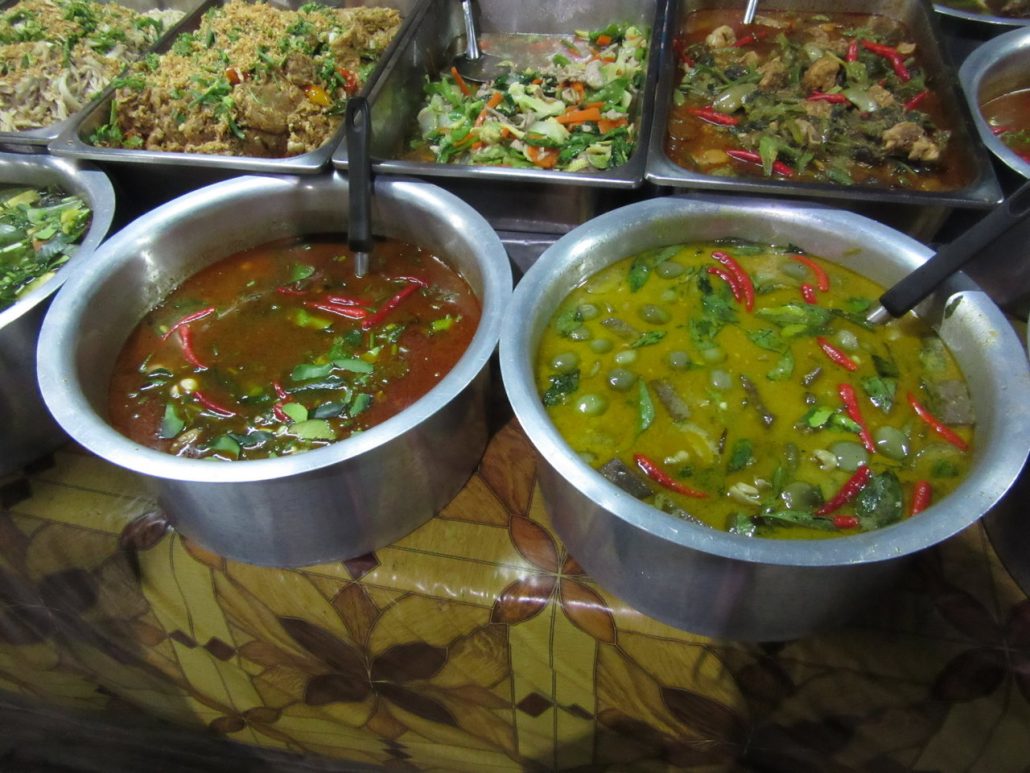
From there it was into the prayer hall. The monks sat along the wall on large chairs that looked like mini sofas. A length of tables ran in front of them. The faithful greeted friends and strangers alike with the traditional S̄wạs̄dī Ka (for women) and S̄wạs̄dī Krap (for men). Being the only Western face in the room, I was introduced more than most.
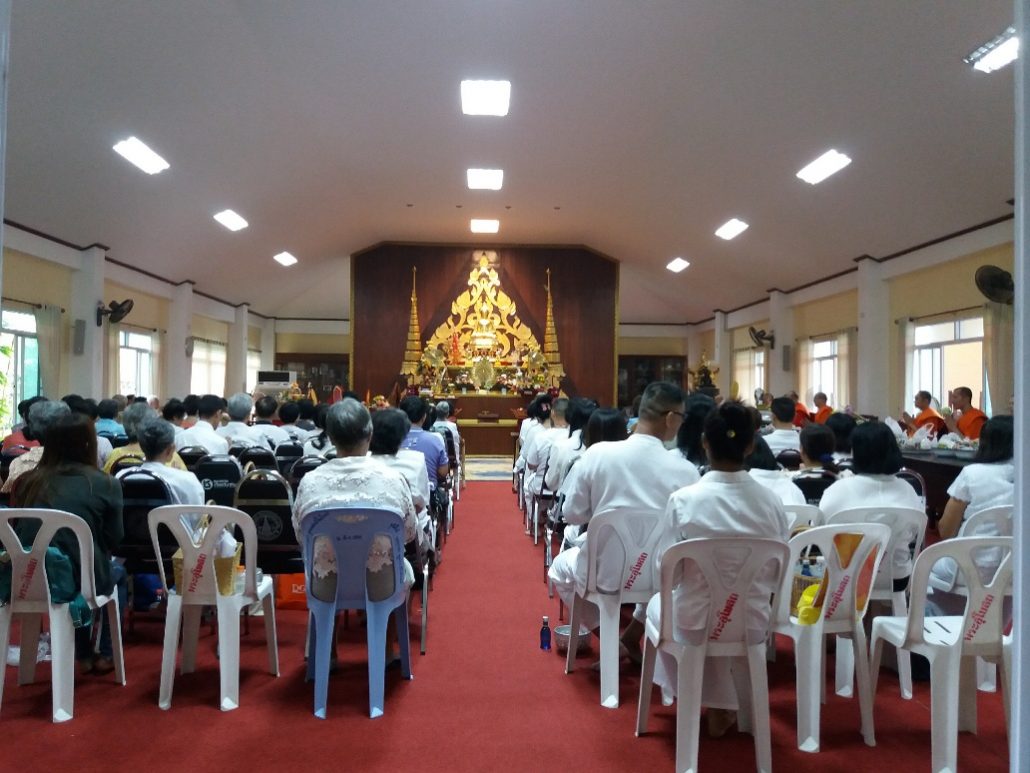
The head monk (?) came out and began the order of proceedings bang on 6.30 am. In what sounded a little like the responsorial psalm, he chanted something to which the congregation replied. This went on for about 30 minutes. Then came their equivalent of our sermon. A younger monk sat, cross-legged, on a wide chair on the dais, brought what looked like a fan in front of his face, and spoke from behind it. He then removed the fan and read from a long, narrow, rectangular piece of bamboo. As he read, instead of words, I heard music and although the meaning escaped me, the beauty of the message was clear. I’ve never heard a voice with such timbre, such resonance. The congregation’s response sounded so flat in return.
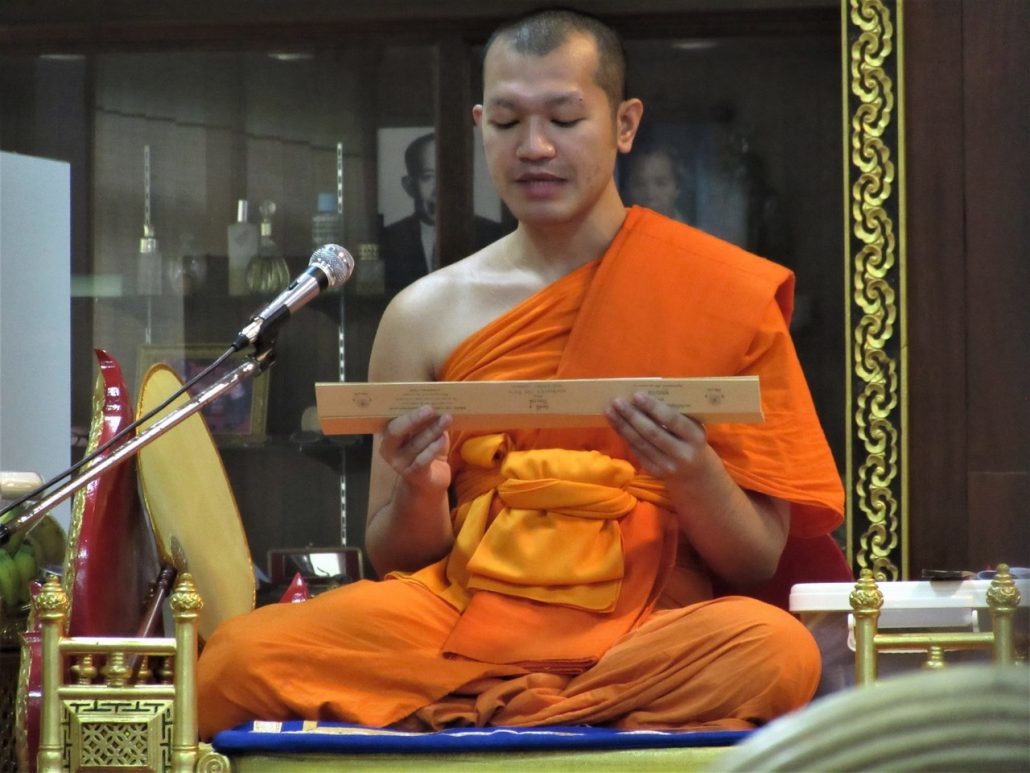
Next, all the monks started to chant in unison. While this was going on, those who preferred to do so, brought up their rice offerings. Others brought in the food offerings from outside and placed them on tables before the monks. I figured this was probably in line with our offertory procession – just far more inclusive. More still had their iPads out, and their phones, and were merrily snapping away. One man was moving about the room with pen and paper and seemed to be taking a silent roll call.

When the offerings had been made, the monks continued to chant. I noticed a general scramble as people dipped into their baskets of tricks (which contained rice bowls, incense, candles, flowers, food) and pulled out a dish and a bottle or urn of water. They then poured the water into the bowl slowly, almost in harmony with the chant, and set it back in their baskets. Later, when the ceremony was over, they’d pour it on the garden outside the temple door to give strength and good deeds to spirits, thus honouring their dead. I thought this particularly nice. The temple’s gardens
As the monks continued to chant, some people put money into envelopes and brought them in person to the head monk. Others I’d seen discreetly put their offering into a donation box. Either works, depending on the need that’s being fed. Buddhists, too, have a collection plate it would seem, although a far less obtrusive one.
Even though I didn’t understand the words, I knew we were getting the final blessing at about 7.50. The telltale rustling and closing of missals, the packing up, the anxious seats – all pretty universal symbols of a ceremony reaching the final stretch. From there, we went over the school, for the annual group photo. Yes! What luck I have. I’ll be on the wall of Wat Phra Kaew in Chiang Rai for the next year – me and the monks and my friends and the rest of the congregation. I’ll be easy to spot. They’ve promised to send me a copy. The temple has a school for young monks with more than 100 in attendance. They were photographed first. So young. So young.
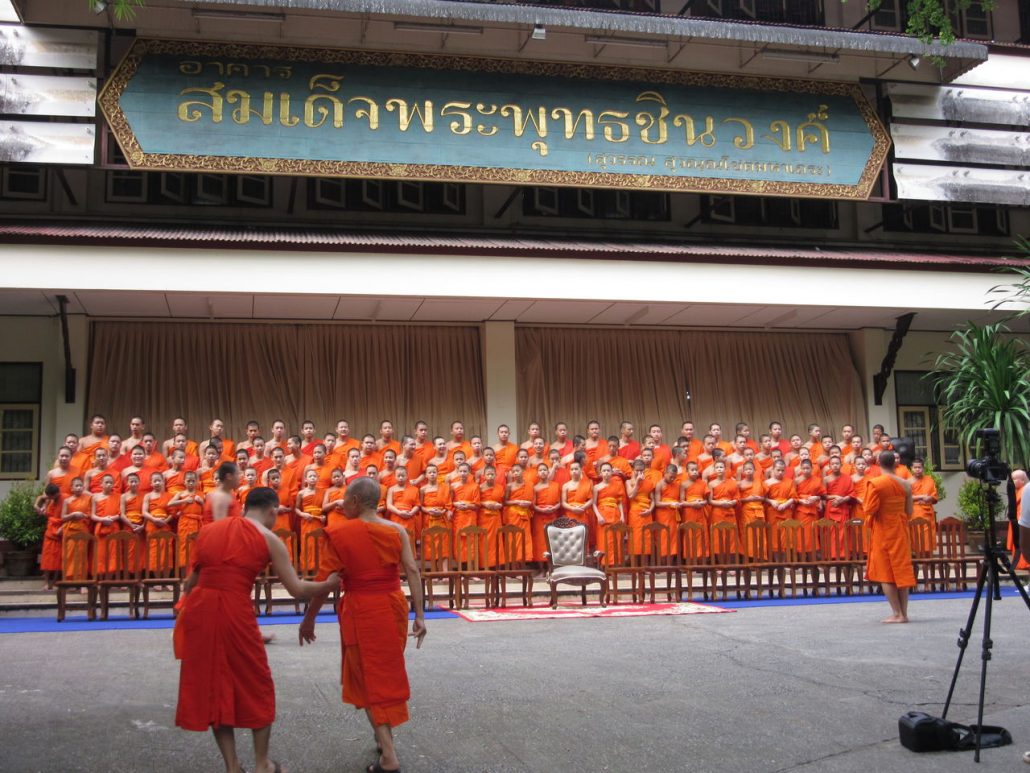
From there it was off to eat in the canteen. People sat at long tables after helping themselves to rice dishes, soups, doughnuts, and sticky rice wrapped in leaves. Quite the feed. This is usual practice, apparently. They bring food for the monks and the monks, in turn, feed them – the circle remains unbroken.
I had a quick few minutes to look around before we headed home. Wat Phra Kaew is home to the Emerald Buddha (Phra Kaew Morakot), discovered in the mid-fifteenth century when the chedi housing it was struck by lightning. The original is now in Bangkok in a temple of the same name on the grounds of the Royal Palace. The one in Chiang Rai, carved in China from Canadian jade, is a slightly smaller, but true copy.
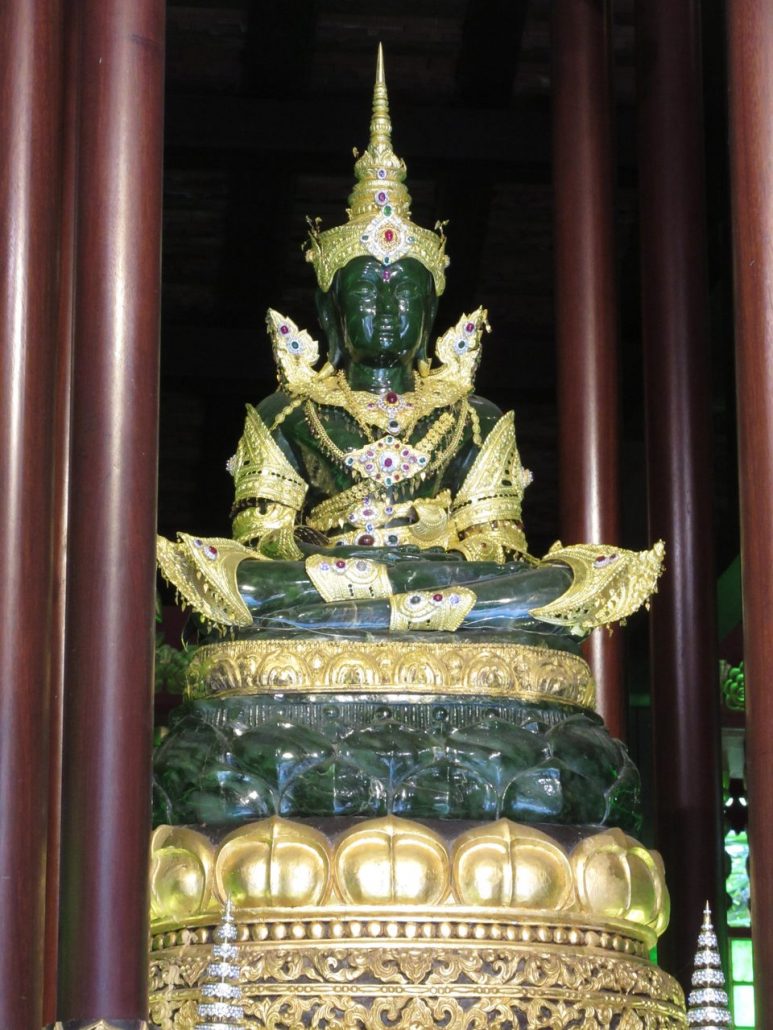
Wat Phra Kaew is also home to the largest and, as it is said, most beautiful Buddha images in Thailand: Phra Jao Lan Thong. The brass and copper image is thought to be 700 years old. Housed in what I think is the ubosot (or is it the viharn?), the building itself is fiercely guarded by two large Naga. I’d spent my temple time so far thinking these were dragons, but they’re snakes, mythical creatures said to be half-human with all sorts of back stories.


Wat Phra Kaew is a beautiful temple. It was a beautiful ceremony. They are such beautiful people. Perhaps it was because I’d put in the hours or maybe it was because the place was overrun with benevolent monks, I was very taken with the place. It felt holier, less touristy than others I’ve been to, more real. And this despite the up-to-the-minute technology and QR codes,
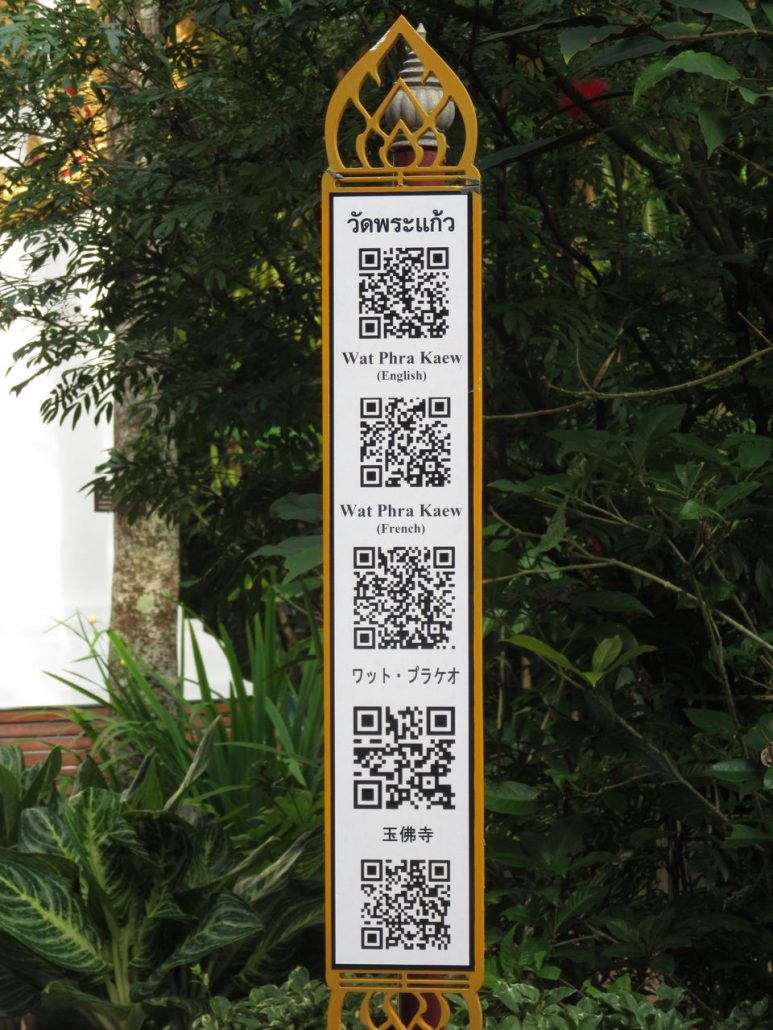

The museum wasn’t yet open but the gardens are littered with all sorts of statuary. Elderly monks were linked back to their quarters. Young novices hung around. Other still were on their phones (something I simply cannot get my head around). It was all go and yet all so serene. In my short time in Thailand, I’ve come to appreciate the respect in which monks are held. Bus stations, train stations, and airports all have seats reserved for them that you sit in at your peril. People part in the streets to let them pass. It’s all so very, very different (and sadly so) from our priests. I was struck, and not for the first time, by the simplicity of their concept of making merit.
According to Buddhism, good deeds or ‘acts of merit’ bring happiness to the doer both in this world and in the hereafter. Acts of merit are also believed to lead towards the final goal of everlasting happiness. The acts of merit can be performed through body, speech or mind. Every good deed produces ‘merit’ which accumulates to the ‘credit’ of the doer. Buddhism also teaches that the acquired merit can be transferred to others’ it can be shared vicariously with others. In other words, the merit is ‘reversible’ and so can be shared with other persons. The persons who receive the merit can be either living or departed ones.
This was one of the highlights of my trip to Thailand, an honour and a privilege indelibly marked on my consciousness. I left, promising myself to continue making merit and to be a little more mindful in thought and prayer. Valuable lessons indeed. Thank you, P&A, for sharing your faith with me.
Interesting articles associated with Buddha and Buddhism
The use of incense in Buddhism
Legend of the Emerald Buddha
More on the Nagas
How to address a Buddhist monk
The monks’ rules
More on making merits
Share this:
- Click to share on X (Opens in new window) X
- Click to share on Facebook (Opens in new window) Facebook
- Click to share on Pinterest (Opens in new window) Pinterest
- Click to share on LinkedIn (Opens in new window) LinkedIn
- Click to share on Reddit (Opens in new window) Reddit
- Click to share on WhatsApp (Opens in new window) WhatsApp
- Click to share on Pocket (Opens in new window) Pocket
- Click to share on Telegram (Opens in new window) Telegram
- Click to email a link to a friend (Opens in new window) Email



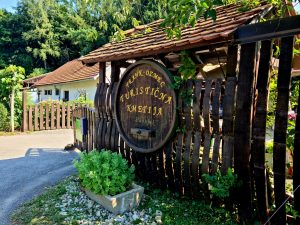



4 responses
Looking forward to you posting the group photo………will we be able too pick you out?
There isn’t enough skin-whitening cream in the whole of Thailand to make any of them as pale as I am. And that stuff is sold everywhere. I’ll certainly stand out.
P and A say you are very welcome. Well put. Mary
Thanks
You might ask what they call the head monk there? Bugs me that I can’t find a definitive answer anywhere.